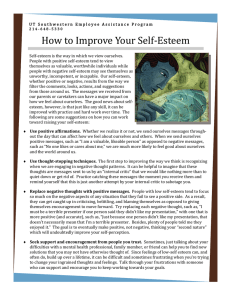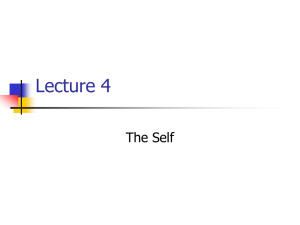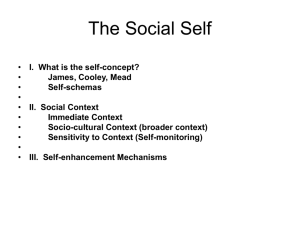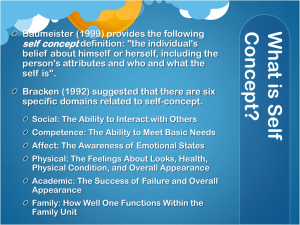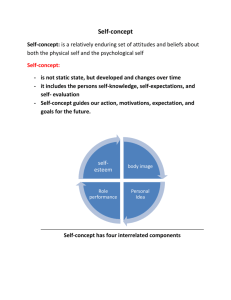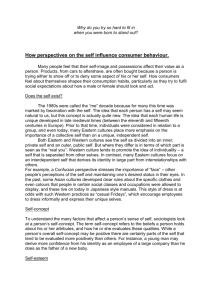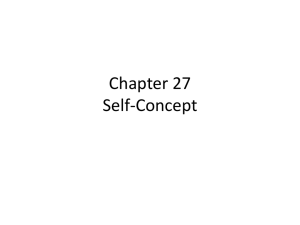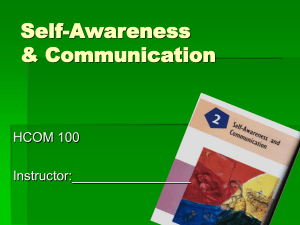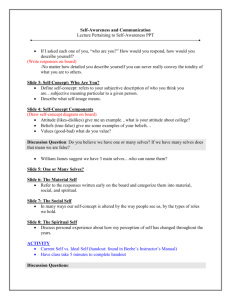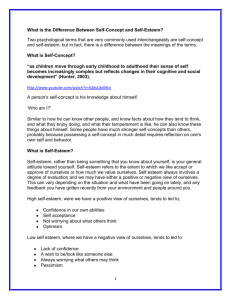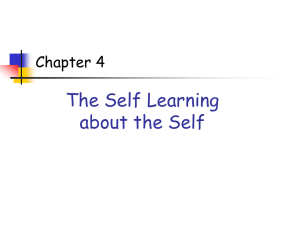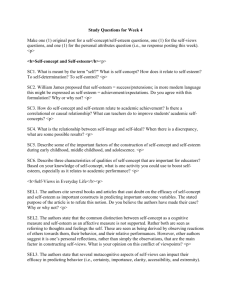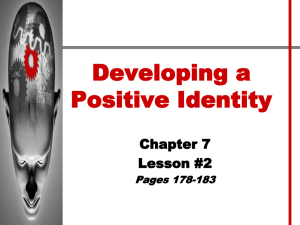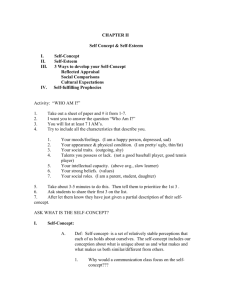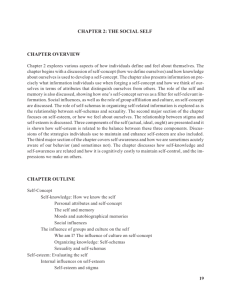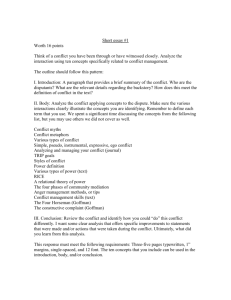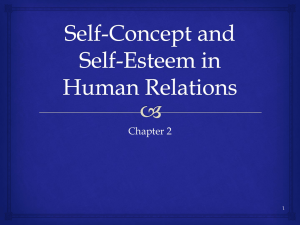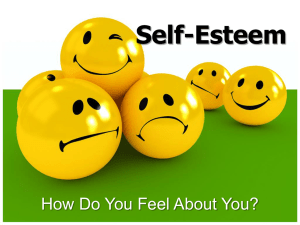Ch 3 PP
advertisement
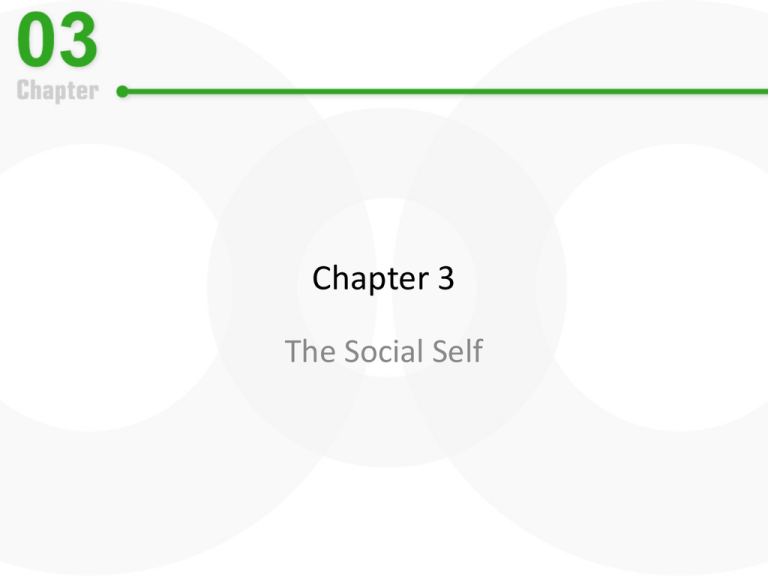
Chapter 3 The Social Self The Role of the “Self” • Capacity for self-reflection is necessary for self-understanding – Private, “inner” self • Self is heavily influenced by social factors. – Public, “outer” self The ABCs of the Self • Affect: How do we evaluate ourselves, enhance our self-images, and defend against threats to our self-esteem? • Behavior: How do we regulate our actions and present ourselves according to interpersonal demands? • Cognition: How do we come to know ourselves, develop a self-concept, and maintain a stable sense of identity? The Self-Concept • Self is an important object of our attention. – Cocktail party effect. • Self-Concept: The sum total of beliefs that people have about themselves. • Self-concept is made up of self-schemas. – Self-Schema: Beliefs about oneself that guide processing of self-relevant information. Introspection • Self-knowledge through looking inward at one’s own thoughts and feelings. Looking glass self. • But does introspection always lead to accurate self-knowledge? – Wilson (2002): Introspection can sometimes impair self-knowledge! How? Other Problems With Introspection • We have difficulty in predicting responses to future emotional events. – Affective Forecasting • We tend to overestimate the strength and duration of our emotional reactions. – For negative events, we do not fully appreciate our psychological coping mechanisms. – We focus only on the emotional impact of a single event, overlooking the effects of other life experiences. Perceptions of Our Own Behavior • Daryl Bem (1972): People can learn about themselves simply by watching their own behavior. • Self-Perception Theory: When internal cues are difficult to interpret, people gain insight by observing their own behavior. – But only in the absence of compelling situational pressures. Self-Perceptions of Emotion/ Affect • Facial Feedback Hypothesis: Changes in facial expression can lead to changes in the subjective experience of emotions. • Laird (1974): Facial expressions affect emotion through process of self-perception. – Alternative explanation: Facial movements evoke physiological changes that produce an emotional experience. Self-Perceptions of Motivation • Intrinsic versus Extrinsic Motivation. – Intrinsic Motivation: Originates in factors within a person – Extrinsic Motivation: Originates in factors outside the person • What happens to intrinsic motivation once a reward is no longer available? – Overjustification effect • Should rewards be offered? Social Comparison Theory • Festinger (1954): When uncertain about our abilities or opinions, we evaluate self through comparisons with similar others. • Key Questions: – When do we turn to others for comparative information? – With whom do we choose to compare ourselves? Autobiographical Memories (cont.) • Essential for a coherent self-concept. • Typically report more events from the recent than the distant past. • Flashbulb memories serve as prominent landmarks in our autobiographies. • Autobiographical memory is a vital part of, and can be shaped by, our identity. – Often motivated to distort the past in ways that are self-inflated. Cultural Influences on the Self-Concept • Self-concept is also influenced by cultural factors. • Contrasting cultural orientations: – Individualism: One’s culture values the virtues of independence, autonomy, and self-reliance. – Collectivism: One’s culture values the virtues of interdependence, cooperation, and social harmony. Why Do We Have a Need for Self-Esteem? • Self-esteem: Affective component of self, consisting of a person’s positive and negative self-evaluations • Satisfying this need is critical to our entire outlook on life. • Those with a positive self-image tend to be happy, healthy, productive, and successful. • Those with a negative self-image tend to be more depressed, pessimistic about the future, and prone to failure. • But does high self-esteem ensure desirable life outcomes? Are There Gender and Race Differences? • Like individuals, social and cultural groups differ in their self-esteem. • Gender differences? – Among adolescents and young adults, males outscore females on various general measures of self-esteem. – But this difference is very small, particularly among older adults. • Racial differences? – Blacks have tended to score higher Self-Discrepancy Theory • Self-esteem is defined by the match — or mismatch — between how we see ourselves and how we want to see ourselves. • Self-esteem depends on a number of factors: – Amount of discrepancy between actual self and self-guide. – The importance of the discrepancy to the self. – The extent to which one focuses on one’s selfdiscrepancies. • What makes us more or less focused on our Coping with Discomfort • 1) “Shape up” by behaving in ways that reduce self-discrepancies • 2) “Ship out” by withdrawing from selfawareness God: Like a Camera in the Sky? • For people of faith, thinking about God should trigger a state of self-focus in the way that cameras and microphones do. Self-Regulation • Self-regulation is the process by which we seek to control or alter our thoughts, feelings, behaviors, and urges. • Is self-control a limited resource that can temporarily be depleted by usage? • How much control do we have? Ironic self control Mechanisms of Self-Enhancement • How does the average person cope with his or her faults, inadequacies, and uncertain future? • We often exhibit implicit egotism, a tendency to hold ourselves in high regard. • What methods do we use to rationalize or otherwise enhance our self-esteem? • The Better-Than-Average Effect. Self-Handicapping • Why do we make excuses? – Way of protecting self from seeing failure as due to a lack of ability. • Self-Handicapping: Behaviors designed to sabotage one’s own performance in order to provide a subsequent excuse for failure. Downward Social Comparison • When self-esteem is at stake, we tend to make comparisons with others who are worse off. • Will make temporal comparisons between past and present selves. • If experiencing a tragic life event, we tend to: – Affiliate with others in same predicament who are adjusting well (possible role models). – Compare ourselves with others who are worse off. Are Positive Illusions Adaptive? • Those with the most realistic view of themselves are those who are depressed or low in self-esteem. • Positive illusions are “health-protective” psychological resources that help people cope with adversity. • But, positive illusions can lead to chronic patterns of self-defeating behaviors. Strategic Self-Presentation • Our efforts to shape others’ impressions in specific ways to gain influence, power, sympathy, or approval. • Common strategic self-presentation goals: – Ingratiation: Desire to “get along” with others and be liked – Self-Promotion: Desire to “get ahead” and gain respect for one’s competence Strategic Self-Presentation Reflections: The Multifaceted Self • Historically, the self has been viewed as an enduring aspect of personality. – Stable over time and slow to change • But at least part of the self is malleable. – Molded by life experiences – Varies from one situation to the next • Self is complex and multifaceted, not simple.

